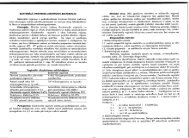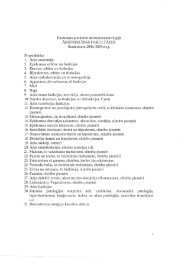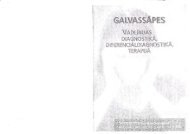PHYSICS
n - susliks.lv
n - susliks.lv
- No tags were found...
Create successful ePaper yourself
Turn your PDF publications into a flip-book with our unique Google optimized e-Paper software.
2.2. THEORY OF ERRORS<br />
2.2.1. Types of Errors<br />
If the measurements are physically derived using measuring<br />
tools, they are referred to as direct; if derived using a formula,<br />
they are indirect. For example, determining the length of an<br />
object with a metric ruler is a direct measurement, while determining<br />
the moment of inertia using the formula I = mr', is an indirect<br />
measurement.<br />
The measured value for a quantity always differs from the true<br />
value for the quantity. The reasons for the difference are instrumental<br />
measurement errors (due to the imperfection of the measuring<br />
instrument) and personal errors (due to measuring errors by<br />
the individual). Another method for classifying errors is based on<br />
their properties. An error is systematic if it is constant over several<br />
measurements or random if it changes during the measurements.<br />
The following definitions more precisely describe these<br />
terms.<br />
Error - the difference between the determined value of a physical<br />
quantity and the true value.<br />
The foregoing classification of measurement errors is based on<br />
the cause of the errors.<br />
Systematic errors are caused by the imperfection of measuring<br />
methods and inaccuracy of instruments. These errors remain constant<br />
or change in a regular fashion in repeated measurements of<br />
one and the same quantity.<br />
Random errors mean the individual errors that are given rise to<br />
the person performing the measurements; they include errors<br />
owing to incorrect reading of the tenth graduation of an instrument<br />
scale, small changes of the measurement conditions, asymmetric<br />
placement of the indicator mark etc. These errors are changing<br />
in an irregular fashion in repeated measurements of one and<br />
the same quantity.<br />
2.2.2. Errors in Direct Measurements<br />
Let x I' X 2'<br />
X 3'<br />
x n<br />
denote the raw data derived from experimental<br />
observations. The arithmetic mean «x» is the sum of observations<br />
divided by the number (n) of observations:<br />
n<br />
LXi<br />
Y. + Y- + Y- +...+ X . I<br />
< X > = 0'1 OV2 oVJ n =-'-=-- (2.1)<br />
n<br />
n<br />
The difference between a data point and the mean is referred to<br />
as a deviation (8):<br />
8. = x. - < x > (2.2)<br />
I<br />
I<br />
Dispersion or variance (0'2) is defined as the sum of the<br />
squared deviations divided by n - I:<br />
n<br />
2<br />
LD j<br />
a 2 = ..i..::L- (2.3)<br />
n-l<br />
Sample standard deviation (0') is defined as the square root of<br />
the dispersion by the following formula:<br />
0'=<br />
n<br />
LS;<br />
i;1 (2.4)<br />
n-l<br />
Confidence interval is the difference between the largest and<br />
smallest observations in a sample.<br />
Confidence interval of systematic error (6) is the smallest division<br />
of the measuring instrument.<br />
Confidence interval of random error (~) is defined by the following<br />
formula:<br />
o<br />
.!1 = t<br />
n<br />
:L S;<br />
i;1 (2.5)<br />
n(n-l)<br />
10<br />
11






